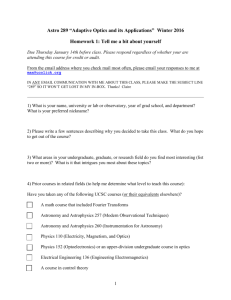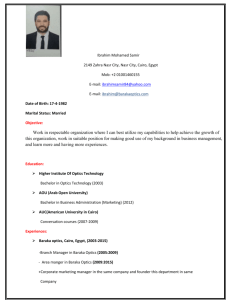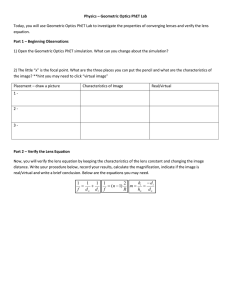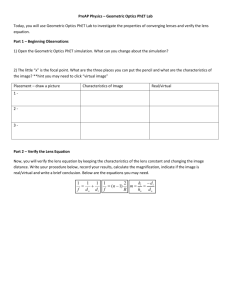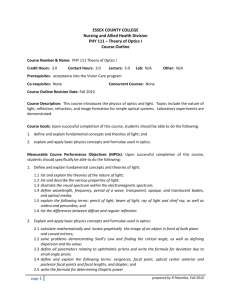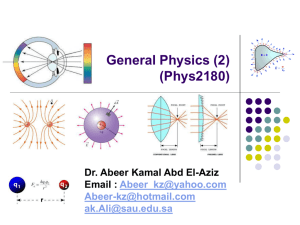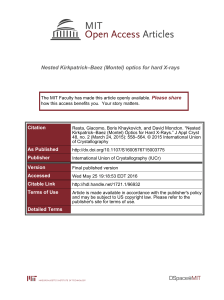Basic optics lab skills
advertisement
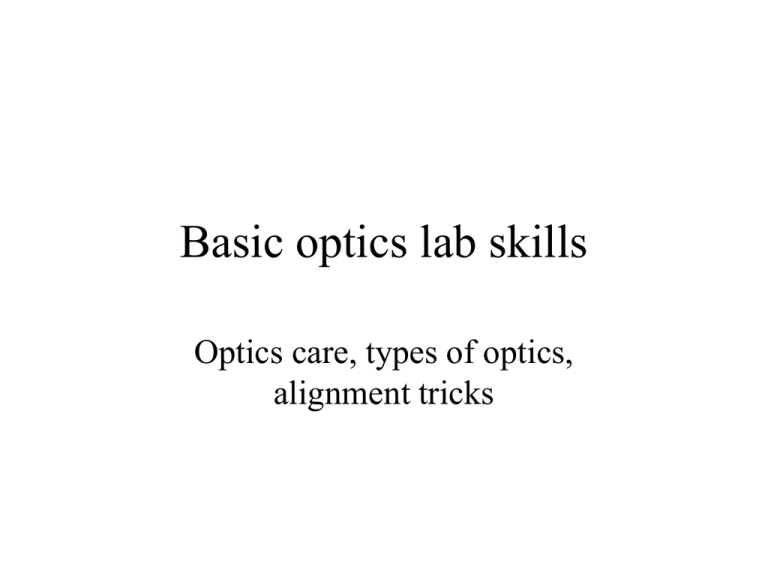
Basic optics lab skills Optics care, types of optics, alignment tricks Optics care Don’t let it get dirty in the first place • Not all optics can be cleaned • Probability of damage exists with each cleaning attempt Never touch coatings -- easy to say, hard to do -- improve with practice • Handle only by edges • Have clean hand or wear gloves • If touched, clean immediately -- oils chemically attack coatings Don’t let dust collect • Dust is abrasive -- tends to scratch during cleaning • Don’t let optics lie face up – Dust tends not to collect on vertical surfaces • why are most optical setups table-top instead of wall-mounted – Ex: set temporarily unused optics on edge • optics on edge may fall and be scratched • usually smaller problem than dust Optics cleaning • Compressed gas – sensitive optics – loosely bound dust • Drag and wipe • Lens tissue held by hemostat Let solvents do the work • Methanol -- general purpose • Acetone -- better organic solvent, toxic – excellent as vapor degreaser – can dissolve optics glues • Isopropanol -- non-toxic, safe for most optics glues • Soapy water -- tough, water based dirt – Ex: flood in room above or sewer line breaks above optical table • De-ionized water -- use as rinse after soapy water -- follow with methanol Types of optics Passive • Mirrors • Beamsplitters -- partially reflecting mirrors • Lenses and lens assemblies • Polarizing elements Active • Modulators -- acousto optic, electro optic • Liquid crystals -- shutters, spatial light modulators (SLM) • Gain media -- lasers • Nonlinear optical elements • Samples under study • Detectors -- photodiodes, power meters Alignment tricks General • Fix beam height on table -- always keep ruler handy – – – – Ex: six inches -- usually high enough Reduces 3-D alignment problem to 2-D problem Polarization rotation issues avoided Allows more stable, fixed height mounting • can do sensitive experiments w/o floating table • Mirrors – Tilt angle important -- use tilt plate mount – Position less important -- but stay away from edge -- 1.5 beam diameters • Lenses – Position important -- use translation mount – Angle less important -- but can cause aberrations • Other, more complicated elements – Better to show than tell Long-term alignment Use irises • Laser beam has position and angle - 4 dimensions – two mirrors give enough degrees of freedom – two irises needed to define • Divide complex setups into sub-assemblies – 2 mirrors, 2 irises are 1st elements in each sub-assembly • Can use servo control to stabilize – replace irises with position sensing diodes – many commercial devices incorporate – build one here ? Iris Iris Optical sub-assembly Mirror Mirror Input Mirror mounts • Tilt plate – plate thickness, spring stiffness, contact smoothness • All not alike – test with laser and long room Prefer 3/8 -- 1/2 ” groove Mount plate Adjust screw Hard, smooth inserts dimple flat Support plate Mount plate Lens mounts Translation mounts • less critical than mirror mounts • long focal lengths -- large translation gives small alignment change • short focal lengths -- spatial filters and microscopes – all spatial filter designs flawed Mirror and lens mounts • Magnetic base -- easy to change setup • Fixed standard height -- more stable Experimental technique • Most people either Type 1 or 2 – depends on personality • Type 1 – Quick setup -- try right away – If not successful -- fix something, try again – Repeat forever • Type 2 – Methodical setup – Works 1st (or 2nd) time – Takes forever before 1st attempt • Best approach – Start with type 1 – If not successful after several attempts -- do type 2 • Easier to say than do – Difficult for both personalities
